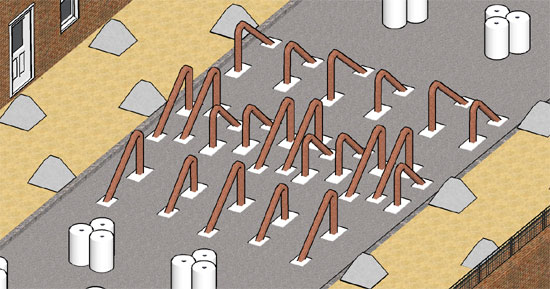Roadblocks
Posted: 22 July 2008 22:34
I've been meaning to post some info on the roadblock report I recently found and a side-project it has stimulated.
The report itself was compiled in 1941 and is a survey of all roadblocks in the East Sussex Divisional Area.
It appears that a lack of accurate records sparked the survey in order to establish the current situation and how much material would be required to bring all blocks up to a set standard of four rows of bent rails or bent RSJs (also known as hairpin rails, these were inserted into concrete sockets set into the road surface) with two rows of cylinders on both sides, with gaps on the flanks protected by rows of pimples. Taking a plan and elevation diagram from the report, I reconstructed this design of roadblock in Google Sketchup; an image is shown below.

Such lists of roadblocks that existed were copied and sent out to commanders in each of the four sectors as arranged by 55 Division, namely 'A', 'B', 'C' and 'Northern' Sectors, who were then to correct the list for their area and state whether each block was still required or redundant.
The returned lists lead to each block location being visited and a record made of every single cylinder, buoy, hairpin rail and sockets etc across the Divisional area. The idea was to then remove materials from the redundant blocks to bolster the current ones.
This is why this report is so significant; it's the only document I've found to date that gives even a slight impression of the 'complete' situation of any defence type at a given time across the entire area I'm studying.
I use 'complete' with inverted commas as permanent barricades across streets are not included (I know of about 80 of these from other sources); it appears that just those blocks to be closed on 'Action Stations' were included in the report.
Due to the immense detail available, I decided to undertake a side-project using the data.
The first job was to create and populate a new database with the entire survey. This was no easy task; the survey comprised 473 roadblocks, each of which had 35 fields of information associated with it, making a total of 16,555 values (or null values) to be accurately entered. This data entry process took about 10 days to do.
Once this was done, I then had to verify and correct the data entered. Fortunately, the report had several statistical tables of totals of materials by sector, allowing me to find data input errors reasonably quickly. In all, I uncovered about 30 mistakes on my part - not bad out of over 16,000 values!
The other problem was where the report's compiler had himself made errors; going back over the raw data, I found a few oversights, but some mistakes could not be accounted for.
It's a fascinating dataset, but only part of the project. Using the roadblock database, I intend to visit as many locations as possible over the summer to see what evidence still remains.
I'll write in more detail on dedicated pages on the site in the near future, and possibly make part of the database available with limited functionality, depending on how much time I have.
Otherwise, keep an eye on this blog for regular updates!
- Pete

Email:
Blog Latest

Bishopstone reveals its pillbox secrets
18 October 2021

Pillbox or Observation Post?
10 June 2020

Uncovering the hidden secrets of a pillbox
8 June 2019

Review of 2018
31 December 2018

Wartime Christmas in East Sussex (2)
24 December 2018
Jargon-buster
Action Stations
A state of readiness issued whenever invasion was deemed imminent. This alert required 100% manning of defences.
Cylinders
Reinforced concrete cylindrical obstacles with a shaft down the centre in which could be inserted a crowbar for manhandling, or a picket for barbed wire. Cylinders were 90cm high and 60cm wide and deployed in groups of three as a more effective alternative for buoys.

Pimples
Small anti-tank block in the form of a truncated pyramid. Pimples were used to extend anti-tank obstacles and roadblocks and were intended for use on soft ground.
Sockets
Concrete-lined shafts dug into road surfaces into which rails or RSJs (hairpin or straight) could be inserted to form a roadblock. When not in use, a wooden cover was placed over each socket.
This site is copyright © Peter Hibbs 2006 - 2024. All rights reserved.
Hibbs, Peter Roadblocks (2024) Available at: http://pillbox.org.uk/blog/216555/ Accessed: 27 July 2024
The information on this website is intended solely to describe the ongoing research activity of The Defence of East Sussex Project; it is not comprehensive or properly presented. It is therefore NOT suitable as a basis for producing derivative works or surveys!